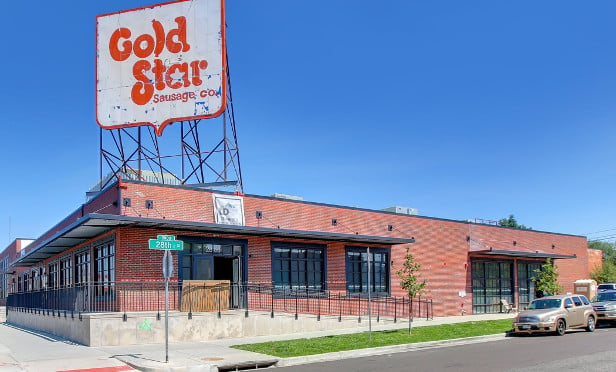SAN DIEGO—Incoming tenants at the former Gold Star Sausage Co. factory site in Denver are being offered a generous allowance in improvements and finishes, thanks to owner San Diego-based Pathfinder Partners. As we previously reported, Pathfinder acquired the property, 2800 Walnut in Downtown Denver's RiNo (River North) district, in 2015 and adapted the 65-year-old, 47,000-square-foot structure for its new use as a creative-office and retail space, putting it through an extensive $7.4-million renovation. The firm is now allowing its tenants to have the last word as to how the interior spaces will look.
We sat down with Pathfinder senior associate Christopher Gibson to discuss the project and how tenant-improvement allowances work in this type of arrangement.
GlobeSt.com: What are the benefits to both landlords and tenants of providing generous tenant-improvement allowances like those at 2800 Walnut?
Gibson: Generous tenant-improvement allowances like these provide numerous benefits to both the landlord and tenants. For the tenants, opening a new location or business and building out the space from a cold shell can be a very capital-intensive endeavor. Significant upfront capital is required during a period when cash flow will not be generated for months. The allowance may also provide a tenant the ability to create a more enhanced space that may not have been possible without assistance from the landlord.
Often, landlords charge an administrative fee to manage the construction process. If a tenant utilizes the allowance and manages the construction, instead of paying fees, tenants can use the entire allowance toward tangible improvements. Tenants can use as much or as little of the allowance to improve their suites and make as many changes during the construction as they deem necessary. If the tenants don't use the entire improvement allowance, they can save the credit for future upgrades to further enhance the utility of their suite or even use the excess funds to offset against rent payments.
For landlords, the biggest benefit is the ability to reduce uncertainty and forecast costs by providing a set allowance. This is especially important with adaptive-reuse projects and in the current environment of escalating labor and material costs. If the tenant needs additional funds, the landlord can offer additional allowance funds and amortize any additional costs, with interest, in the tenant's future lease payments. Amortizing additional costs increases the rental rate, which ultimately increases the building's terminal value. An allowance also hands over day-to-day construction oversight responsibility to the tenant while still providing the landlord oversight approval by virtue of his control of the improvement funds. This not only frees capacity for the landlord, but also mitigates the risk of delivering the space in a specific time frame and specification. If delays are caused by the landlord, the financial consequences could be severe, with tenants requesting additional free rent or other concessions detailed in their lease.
GlobeSt.com: Who typically oversees the work? Is the tenant provided a list of vendors/contractors?
Gibson: By providing a tenant-improvement allowance rather than a turn-key space, the landlord transfers primary responsibility for overseeing the construction to the tenant. If the landlord performs tenant improvements on a speculative basis, the landlord is essentially guessing about what improvements future tenants will require. With tenant-improvement allowances, tenants maintain control over the ultimate improvements to the space and can hire their preferred vendors and customize the improvements to their desired specifications. While the tenant is responsible for the majority of the oversight, including lien releases, permits and certificates of occupancy, the landlord—or his designated construction representative—still maintains the ability to approve plans and signage and the general contractor contract and can monitor and inspect construction progress and control the release of payments.
Given the adaptive reuse nature of the Walnut St. building, we can provide recommendations of contractors who are already familiar with the building and save the tenants money, time and headaches along the way.
GlobeSt.com: Does the tenant have any constrictions or guidelines they must follow?
Gibson: The tenants typically have reasonable latitude to improve the interior of their suites as they see fit so long as the plans are approved by the proper authorities and do not affect the building's core systems—any change to mechanical, electrical or plumbing systems and the building shell often require landlord approval. Any exterior improvements such as signage or paint generally also require the tenant to follow specific guidelines set forth by the landlord to retain consistency throughout the project.
GlobeSt.com: What are the challenges to allowing tenants to finish their respective spaces—especially in an adaptive-reuse project such as this?
Gibson: Adaptive-reuse projects represent a delicate balancing act to preserve the building's character and charm—bow-truss roofs, 18-foot-to-25-foot ceilings and rugged brick façade—while modernizing all the systems such as mechanical, electrical and plumbing to meet the demands of today's world. Much like a 1930s-era building has to adapt to the new use, the tenants must adapt to the mosaic of imperfections the buildings have as well. Allowing tenants to finish their suites brings new vision to the interiors; we have been fortunate to have design-oriented tenants with a keen eye for the details and an appreciation for the vintage character of the building. Our tenants—Boffi Studios Denver, Design Wright and Artisan Rug Gallery—have exceeded our expectations with their artistic flair and commitment to high-quality finishes.
Want to continue reading?
Become a Free ALM Digital Reader.
Once you are an ALM Digital Member, you’ll receive:
- Breaking commercial real estate news and analysis, on-site and via our newsletters and custom alerts
- Educational webcasts, white papers, and ebooks from industry thought leaders
- Critical coverage of the property casualty insurance and financial advisory markets on our other ALM sites, PropertyCasualty360 and ThinkAdvisor
Already have an account? Sign In Now
*May exclude premium content© 2024 ALM Global, LLC, All Rights Reserved. Request academic re-use from www.copyright.com. All other uses, submit a request to [email protected]. For more information visit Asset & Logo Licensing.











